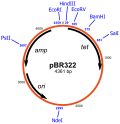Yeast artificial chromosome
Yeast Artificial Chromosome (YAC) is a vector used in genetic engineering to clone DNA fragments that are larger than those cloned by other means. It is constructed from the telomeric, centromeric, and replication origin sequences needed for replication and preservation in yeast cells.
History[edit]
YACs were first described in 1987 by a team led by David T. Burke. They were used in the Human Genome Project, which aimed to map the entire human genome.
Structure and Function[edit]
A YAC is made up of a centromere, two telomeres, and an origin of replication. These are the necessary elements for replication and segregation during cell division. The YAC also contains a selectable marker gene, which is usually the suppressor tRNA gene SUP4. This gene allows for the selection of yeast cells that have been successfully transformed with the YAC.
Applications[edit]
YACs have been used in a variety of applications in genetic research. They were used extensively in the Human Genome Project, and have also been used to study the genetics of other organisms, such as yeast and mice. They have also been used in the study of diseases, such as cancer and Alzheimer's disease.
Limitations[edit]
While YACs have many advantages, they also have some limitations. They can be unstable, leading to the loss of inserted DNA. They can also undergo recombination, leading to the rearrangement of the inserted DNA. These limitations have led to the development of other cloning vectors, such as bacterial artificial chromosomes (BACs).
See Also[edit]
References[edit]
<references />
Ad. Transform your life with W8MD's Budget GLP-1 injections from $75


W8MD offers a medical weight loss program to lose weight in Philadelphia. Our physician-supervised medical weight loss provides:
- Weight loss injections in NYC (generic and brand names):
- Zepbound / Mounjaro, Wegovy / Ozempic, Saxenda
- Most insurances accepted or discounted self-pay rates. We will obtain insurance prior authorizations if needed.
- Generic GLP1 weight loss injections from $75 for the starting dose.
- Also offer prescription weight loss medications including Phentermine, Qsymia, Diethylpropion, Contrave etc.
NYC weight loss doctor appointmentsNYC weight loss doctor appointments
Start your NYC weight loss journey today at our NYC medical weight loss and Philadelphia medical weight loss clinics.
- Call 718-946-5500 to lose weight in NYC or for medical weight loss in Philadelphia 215-676-2334.
- Tags:NYC medical weight loss, Philadelphia lose weight Zepbound NYC, Budget GLP1 weight loss injections, Wegovy Philadelphia, Wegovy NYC, Philadelphia medical weight loss, Brookly weight loss and Wegovy NYC
|
WikiMD's Wellness Encyclopedia |
| Let Food Be Thy Medicine Medicine Thy Food - Hippocrates |
Medical Disclaimer: WikiMD is not a substitute for professional medical advice. The information on WikiMD is provided as an information resource only, may be incorrect, outdated or misleading, and is not to be used or relied on for any diagnostic or treatment purposes. Please consult your health care provider before making any healthcare decisions or for guidance about a specific medical condition. WikiMD expressly disclaims responsibility, and shall have no liability, for any damages, loss, injury, or liability whatsoever suffered as a result of your reliance on the information contained in this site. By visiting this site you agree to the foregoing terms and conditions, which may from time to time be changed or supplemented by WikiMD. If you do not agree to the foregoing terms and conditions, you should not enter or use this site. See full disclaimer.
Credits:Most images are courtesy of Wikimedia commons, and templates, categories Wikipedia, licensed under CC BY SA or similar.
Translate this page: - East Asian
中文,
日本,
한국어,
South Asian
हिन्दी,
தமிழ்,
తెలుగు,
Urdu,
ಕನ್ನಡ,
Southeast Asian
Indonesian,
Vietnamese,
Thai,
မြန်မာဘာသာ,
বাংলা
European
español,
Deutsch,
français,
Greek,
português do Brasil,
polski,
română,
русский,
Nederlands,
norsk,
svenska,
suomi,
Italian
Middle Eastern & African
عربى,
Turkish,
Persian,
Hebrew,
Afrikaans,
isiZulu,
Kiswahili,
Other
Bulgarian,
Hungarian,
Czech,
Swedish,
മലയാളം,
मराठी,
ਪੰਜਾਬੀ,
ગુજરાતી,
Portuguese,
Ukrainian




